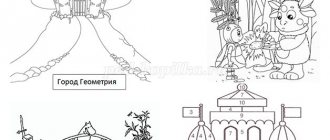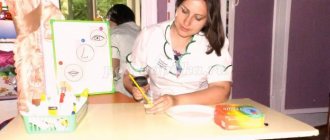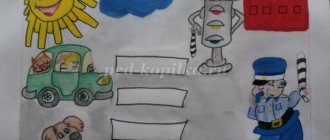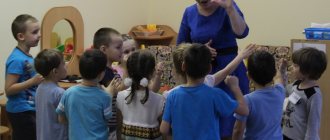Self-analysis of the NOD “Visiting the Old Forest Man”
author: Merkusheva Alena Alexandrovna
teacher at MBDOU "Kindergarten No. 9", Shadrinsk
Self-analysis of the NOD “Visiting the Old Forest Man”
Self-analysis of the educational activity “Visiting the Old Forest Man” in the senior group.
Direct educational activities were carried out in the older group, with children from 5 to 6 years old, 8 people were present. GCD theme: “Visiting the Old Forest Man.”
The software content includes 3 groups of tasks:
Educational:
1. Learn to answer the questions posed in complete sentences.
- Strengthen the ability to write a descriptive story about wild animals.
- Learn to form possessive adjectives (which answer the questions whose, whose, whose)
- Form a vocabulary on the topic “Wild animals and their young.”
- Expand your vocabulary of antonym words.
Educational:
- Develop logical thinking and creative imagination.
Educational:
- Develop goodwill in communication.
- Arouse children's interest and their emotional response.
- Cultivate cognitive interest and curiosity.
The GCD is built in accordance with the basic principles of the Federal State Educational Standard.
The assigned tasks were implemented through the integration of the areas: “Speech development”, “Cognitive development”, “Socio-communicative development”.
During the lesson, sanitary and hygienic requirements were observed: time, change of activities.
I believe that the material was selected at a level accessible to children, taking into account their age characteristics.
The logical structure of the lesson made it possible to conduct it without going beyond the time allotted for completing the task.
I believe that the variety of equipment and materials used in the lesson allowed me to keep the attention and cognitive interest of the children throughout the lesson.
During the lesson, various methods and techniques were used: the game method, which implies a surprise moment, creating a game situation; visual method (demonstration of manuals, illustrative material); verbal method (conversation, guessing riddles, composing stories using the Rings of Lull, using a mnemonic table, questions, explanation); practical (doing physical exercises for a minute). The method of control and stimulation was carried out in the form of approval and praise.
Individual assistance was provided only to children in need. All children were given the right to choose throughout the NOD.
The motivation tool was the creation of a game situation, the use of TRIZ technology, and the use of technical teaching aids (TST). This influenced interest in the lesson, creating an emotional mood.
Children, while completing tasks, showed interest, activity, and independence.
I am sure that the children liked NOD. The children got new impressions and left in a good mood.
I would like inactive children to show more activity. I will strive for this in future work.
The content of the lesson corresponded to the assigned tasks.
I believe that the tasks set in direct educational activities were completed.
- The principle of full-fledged living for a preschool child, enriching child development.
- The principle of constructing educational activities based on the individual characteristics of each child, in which the child himself becomes active in choosing the content of his education, becomes the subject of preschool education.
- The principle of assistance and cooperation between children and adults, recognition of the child as a full participant (subject) of educational relations.
- The principle of supporting children's initiative in various activities.
- The principle of cooperation with the family.
- The principle of introducing children to sociocultural norms, traditions of the family, society and state.
- The principle of the formation of cognitive interests and cognitive actions of a child in various types of activities.
- The principle of age adequacy of preschool education (compliance of conditions, requirements, methods with age and developmental characteristics).
- The principle of taking into account the ethnocultural situation of children's development.
Self-analysis of the NOD “Visiting the Old Forest Man”
Self-analysis of educational activities on social and communicative development in a different age group of preschool educational institutions.
Municipal autonomous educational institution
"Progymnasium Kristallik"
Self-analysis classes for the senior subgroup in the middle school
group "Watercolors"
Educational field “Social and communicative development”.
Subject: «
Such a different mood"
Prepared by:
Educator Vilman L.G.
10.02.2016
Saratov 2016
| Topic: “ Such different moods” |
Educational field: “Physical development”
Software tasks:
- develop physical qualities;
— improve the ability to participate in outdoor games;
— to form the preservation and strengthening of physical and mental health;
- ensure physical activity during the games;
Educational field: “Socio-communicative development”
Software tasks:
- develop play activities;
— create an atmosphere of goodwill and readiness for joint activities;
— develop emotional intelligence.
Educational field: “Speech development”
Software tasks:
- develop coherent speech in children;
- develop the ability to take part in a conversation, express one’s opinion, listen to the opinions of comrades, participate in a collective conversation;
- activate your vocabulary.
Educational field: “Artistic and aesthetic development”
Software tasks:
-develop the ability to perceive poetic works;
-develop the ability to empathize with the characters of works of art.
Educational field: "Cognition"
Software tasks:
-activate cognitive interest;
- clarify children’s knowledge about basic human emotions.
Vocabulary work:
gestures, pictogram
,
facial expressions.
Equipment and materials:
pictograms sun-clouds, puzzles “Fairytale heroes”.
Preliminary work: conversation
“I laugh and I’m sad”, reading works of fiction “a good man” by R. Sef. “joy” by L. Voronkov.
Integration of educational areas “Speech development”, “Cognitive development”, “Social and communicative”, “Physical development”, “Artistic and aesthetic development”
Analysis of goals and objectives.
The lesson was held in the senior subgroup of the middle-senior group “Watercolors”. The lesson consisted of three interconnected stages, during which children gradually performed various actions. This structure is completely justified, since each stage of the lesson is aimed at solving certain problems and offers a choice of methods and techniques. Goals and objectives correspond to the targets of the Federal State Educational Standard for Education. To achieve the goal, an educational environment has been created; goals and objectives correspond to age capabilities. There is a connection between goals and objectives and the theme of educational activities. The objectives were formulated specifically and corresponded to the level of development of the children.
Analysis of organized educational activities.
During the lesson, a person-oriented model of activity was used. The children demonstrated their knowledge of software materials and acquired the knowledge themselves. Questions of a problem-search nature predominated. The following methods were used to activate children:
1. Verbal (conversation, questions to children, poetry reading);
2. Visual - demonstration (presentation, pictograms, sun-clouds as a symbol of mood);
3. Practical (compiling a puzzle);
4. Game (the outdoor game “The King Was Walking”, the psychological game “We Too”);
Techniques: play, explanations, instructions, demonstration, artistic expression, encouragement, individual work, analysis, conversation.
The fulfillment of the tasks I set was also helped by leading questions that pushed the children to make independent statements. Questions and tasks were selected so that all children could participate equally in the work. The questions were simple and understandable to the children; if the question caused difficulty, then a problematic situation was created, which activated mental speech activity and led to the need to independently find a solution. I tried to arouse children’s interest in the type of activity, diversify the material and tasks, create a friendly atmosphere during the lesson, clearly formulate questions that correspond to the level of development of the children, the objectives of the lesson (appealing to the experience of children, creating problematic situations).
All the children freely turned to me for help when faced with difficulties in solving a particular issue. Throughout the lesson, problematic situations were created to solve the assigned problems.
At the beginning of the lesson, I used techniques to evoke in children the internal need to be included in the activity; the children were asked to watch a presentation about the different moods of a person, thus the children were included in the activity. The goal of the OD corresponded to individual characteristics, the specifics of personal motives, the emotional sphere, and the cognitive interest of the children in the group. In preparation for the lesson, demonstration and handout materials were selected and produced, taking into account the age characteristics and interests of the children. The arrangement of children in space is thoughtful - conversation - standing on the carpet and sitting at tables, games on the carpet, putting together a puzzle on the carpet. All this contributed to the effectiveness of the lesson, mental activity and speech development of children. All elements of the lesson are logically united by a common theme.
I tried to arouse children’s interest in the activity and diversify the material and tasks. The amount of information was sufficient. During educational activities, various forms of work were combined:
-group;
-individual.
During the lesson, I tried to maintain the children’s interest and conscious attitude towards the activity being performed.
During the lesson, the following integration of educational areas was observed: “cognitive development”, “socio-communicative development”, “speech development”, “physical development”, “artistic and aesthetic development”, which were implemented in accordance with the age capabilities and characteristics of the children.
To develop cognitive interest and cognitive activity throughout the entire educational process, children showed initiative, creativity, and independence. When performing tasks, the following types of activities were used: communicative, cognitive - research, artistic - aesthetic, motor. One type of activity smoothly transitioned into another. To implement each task, I selected techniques that helped solve them. The techniques were based on playful learning situations in which I tried to encourage children to engage in active speech activity. The material for the educational situation was selected at a level accessible to children, corresponded to their psychological and age characteristics and was rational for solving the set goals and objectives. The children were active, attentive, and felt comfortable. During the lesson, the dialogic style of communication prevailed. The level of complexity of the tasks corresponded to the children’s capabilities; the individual characteristics of children were taken into account when selecting content, forms of support and stimulation of search and creative activity. Throughout the entire educational situation, the continuity of the storyline, the presence of a logical connection between the stages, the preservation of targets, motivation and a meaningful attitude to the activity at each stage were maintained. All this is confirmed by the results of our activities.
I believe that the form of organization of the lesson I chose was quite effective and dynamic. The style of communication was predominantly democratic. I tried to be a partner, an assistant for the children, and to observe the norms of pedagogical ethics and tact. She tried to construct her statements competently and easily for children to understand, encouraged children to show initiative and independence, and encouraged children’s individual achievements.
The activities of all children were assessed positively, their personal dignity was not belittled.
She reinforced the positive results of the session with verbal encouragement. Each stage of the lesson is aimed at solving certain pedagogical problems and offers a choice of adequate methods and techniques. Children could independently choose the material and method of action when solving the task.
I believe that the objectives set in the lesson were completed. The activity achieved its goal.
Self-analysis GCD methodological development (senior group) on the topic
GCD Self-Analysis
Compiled by the teacher
Zelenetskaya S.V.
Joint activities with children were carried out in a group of senior preschool age. There are 27 children in my group. The form chosen was subgroup, 8 people. When developing this GCD summary, I first of all took into account the age and mental characteristics of the children of the older (my) group.
GCD on cognitive and research activities topic
"Help Cinderella."
ECD combines educational areas: “Cognitive development”, “Speech development”, “Social and communicative development”, “Physical”. This activity was preceded by a series of experiments (experiments) with different types of materials.
ECD was carried out in accordance with the objectives of the main general education program “From birth to school”, according to which our kindergarten operates.
To implement each task, techniques were selected to help solve software problems in an interesting and entertaining way.
In direct educational activities, she created conditions for the formation of prerequisites for universal educational activities:
- Personal UUD - (during the organizational moment, a respectful attitude towards others was cultivated).
- Regulatory UUD - During the NOD, she constantly tried to raise problematic issues, thereby trying to create conditions for the formation of prerequisites for regulatory UUD.
- Cognitive UUD - the prerequisites for the skills of analysis and synthesis were carried out during the updating of children’s knowledge based on reliance on life experience and children’s knowledge. When describing subjects, a prerequisite for understanding the conscious construction of a speech utterance was formed. During the summing up of educational activities, the prerequisite for the ability to evaluate one’s own activities was formed.
- Communicative UUD - compliance with the rules of communication, carried out in joint activities, construction of small monologue statements, proactive cooperation in searching for the necessary information.
The following technologies were used in the GCD process:
-game activity;
-activity approach;
-learning in dialogue with adults;
-technology of developmental education;
- health-saving technologies.
The children were united by the content of the activity and demonstrated their knowledge at their age level. All this was built taking into account the age and psychological characteristics of children.
The introductory part of the direct educational activity (DEA) involved organizing the children: switching attention to the upcoming activity, stimulating interest in it, creating an emotional mood, setting up for the upcoming activity, and explaining. GCD was aimed at solving a problem-game situation.
The main part of ECD is the independent mental and practical activity of children, aimed at independent mental and practical work, and the implementation of all assigned educational tasks.
The main part of the ECD included tasks for repeating what has been learned and activating basic knowledge in order to repeat what has been learned and lead to the perception of new knowledge, systematizing children’s existing knowledge in independent activities, and consolidating skills.
To mobilize the intellectual capabilities of children and relieve their general fatigue, musical games were held. In addition, changing different types of activities also helped relieve the children’s fatigue.
Direct educational activities were built using elements of modern educational technologies. Individualization of learning was manifested in providing assistance, reminders, additional explanations to children who had difficulty completing tasks, as well as taking into account the peculiarities of thinking and the pace of perception of each child.
To achieve results for each child during the activity, a differentiated approach to learning was provided, expressed in the use of tasks of different levels of complexity, taking into account the level of knowledge and the “zone of proximal development” of each child.
To solve the problems assigned to the children, I used didactic aids, a living object (examination items) to develop logical thinking, memory, attention, and auditory perception.
In the final part, the NOD summed up the activity, using the method of analyzing the success of completing the task and the method of children’s self-assessment of their capabilities.
I believe that the form of organizing the direct educational activities of children that I chose was quite effective. Throughout the entire educational activity, the prerequisites for UUD (universal educational activities) were formed, which will further serve as the basis for the formation of UUD (universal educational activities) in accordance with the requirements of the Federal State Educational Standard of Preschool Education. I tried to comply with the norms of pedagogical ethics and tact.
Conclusion:
GCD corresponds to the assigned tasks. I consider GCD effective because the development of children's speech activity was ensured. Various types of children's activities and forms of their organization and methodological techniques were used.
In addition to all the listed methods, throughout all 3 stages, I tried to use the method of stimulation and motivation: emotional methods, the method of verbal encouragement. I believe that all these methods and techniques used during the lesson contributed to the emotional response of children, the development of interactive speech and communicative relationships, attention and thinking, memory and imagination.
I think that I coped with the tasks that were set, and so did the children. GCD achieved its goal.
A project of self-analysis of educational activities directly.
A project of self-analysis of educational activities directly.
Full name of the teacher
: KeV teacher
OU
: Municipal budgetary preschool educational institution “…. »
Program:
“From birth to school” under. ed. N.E. Veraksa, M.A. Vasilyeva, T.S. Komarova.
Group, age of children
: junior group
Lesson topic:
"Winter Journey".
At the lesson “Winter Journey” the following goal was set: Continue to expand the active vocabulary of children on the topic of winter.
Tasks:
Educational:
Continue to learn to distinguish and name geometric shapes: circle, triangle.
Develop the ability to answer questions, cultivate interest in living nature.
Develop the ability to answer questions.
Educational:
Develop visual perception, attention, thinking, observation.
Develop communication and speech skills.
Develop children's fine motor skills.
Educational:
Encourage children to want to participate in a conversation (conversation) with the teacher.
Foster a sense of responsibility, organization, active attention, and develop the ability to work in pairs.
Integration of educational areas
: Cognitive development + physical development + speech development + artistic and aesthetic development
Types of children's activities:
cognitive activity, productive activity, communicative activity, gaming activity.
Preliminary work:
observing during walks (drifts), looking at paintings, illustrations with images of snowmen, reading books, systematizing knowledge about the circle and triangle.
GCD structure
Direct educational activities (hereinafter referred to as GED)
This direct educational activity (DEA) was carried out with 8 children of primary preschool age.
Taking into account age characteristics, the children answered the teacher’s questions, maintained a conversation, looked at the picture of a snowman with interest, and performed activities and exercises. The children were quite active and felt comfortable.
The following working methods were used at the GCD:
Visual and demonstrative method: showing objects, showing a method of action, showing a picture, using ICT.
Verbal methods: conversation, questions, explanation, surprise moment.
Practical methods: exercise (ICT), construction, dynamic pause.
Game method
Problematic - search engine
Methods include a system of techniques that are combined to solve learning problems. Techniques (explanations, instructions, demonstration, commands, play techniques, artistic expression, encouragement, helping the child, analysis, introductory conversation) are aimed at optimizing the individual development of each child.
The educational activity itself consisted of three interconnected stages, during which children gradually performed various actions. This structure is completely justified, since each part of direct educational activity is aimed at solving certain problems and offers a choice of methods and techniques
Introductory part
organization of children, motivation for upcoming activities. At the organizational stage of the GCD, a surprise moment was used - the appearance of a snowflake.
Main part
ECD was a specially organized and independent activity of children aimed at solving assigned tasks and solving problem situations. (find a pair for a snowflake, a nose for a snowman). The main part: the mental and practical activity of children, tasks were included on mental development and perception of the surrounding world, systematization of existing knowledge, and consolidation of speech skills. To relieve general fatigue, a dynamic pause was carried out. Individual work was manifested in helping those who found it difficult to answer.
In the final part
GCD
To implement each task, I selected techniques that helped solve them. The techniques were based on game situations in which I tried to consolidate the children’s knowledge about geometric shapes and the season - winter.
When working with children, I used conversation, questions to children on attentiveness, intelligence and logical thinking - all this contributed to the effectiveness of educational activities, mental activity and cognitive development of children.
The material for the educational activities was selected at a level accessible to children, corresponded to their psychological characteristics and was rational for solving the set goals and objectives. They were active, attentive, and felt comfortable.
All elements of GCD are logically united by a common theme.
This structure of the lesson is completely justified. Since each part of the lesson is aimed at solving certain pedagogical problems and offers a choice of adequate methods and techniques. The content of the lesson corresponded to the assigned tasks.
Activities at GCD are characterized as joint and individual.
At NOD I used the following forms of work: individual, group.
I believe that the form of organizing the direct educational activities of children that I chose was quite effective and dynamic. I tried to comply with the norms of pedagogical ethics and tact. I believe that the tasks set in direct educational activities were completed! GCD has achieved its goal!



